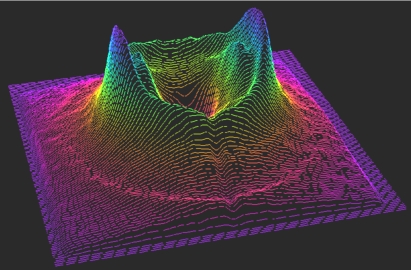 |
|
Monocapillary optics for Small/Wide Angle X-ray Scatter Analysis The requirements of high beam intensity coupled with well-characterised beam intensity distributions at the specimen make focussing monocapillary optics an ideal choice for X-ray scattering applications. Single-reflection beam geometry imposes absolute cylindical symmetry with uniform angular flux distribution, resulting in predictable scattered intensity distributions for numerical deconvolution or integration. Small-angle X-ray Scatter (SAXS) Our paraboloidal and very-long-focus (VLF) ellipsoidal monocapillary optics are ideally suited to SAXS analysis using either microfocus tube sources or high-brightness rotating anodes. The small target sizes of these sources are utilised with very high efficiency to produce slow-convergence (equivalently low-divergence) beams with maximum white-radiation suppression and high symmetry around the beam propogation axis. The high efficiency demonstrated by our optics used with these sources results in beams of greater intensity than those produced by systems using conventional sealed tubes or large-target-focus rotating anodes, even despite the greater power loadings used with the latter source types. Wide-angle X-ray Scatter (WAXS) The advantages offered by focussing monocapillary optics for WAXS are: small beam spot sizes with better intensity for small-specimen or ROI analysis; long working lengths for complex instrumentation or specimen environment cells; better spectral characteristics compared to filtered radiation; more rapid data collection compared to conventional optics; better signal-to-noise ratios in scatter intensity distributions and compatability with all source types including conventional sealed-tube generators. Although other other optics (notably polycapillaries) offer high-intensity beams for WAXS, the large convergence angles employed result in a low incident flux per unit solid angle at the specimen. This results in 'smearing' of the WAXS pattern over the detector, so that while more data overall are recorded, the intrinsic signal-to-noise ratio is not improved. Focussing monocapillaries achieve a much greater incident flux per unit solid-angle at the specimen than is possible using any other optics, and while mainatining a small total incident convergence angle as well. These characteristics lead to sharply defined scatter structures in the WAXS image, occupying fewer pixels, with better deconvolution and integration statistics. |
|
Applications The huge variety of equipment types and combinations used for X-ray scattering analysis invariably requires us to produce custom-made housings in the majority of applications. Please see our Optical design criteria for the information you may need to specify an optical solution to your application, and please contact us for further details. 10-second exposure WAXS image from pine wood using 0.1mm-beam focussing monocapillary optic on 1kW rotating-anode generator |
|
